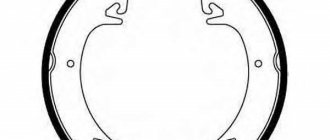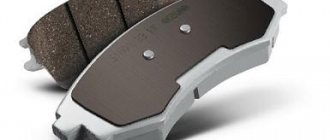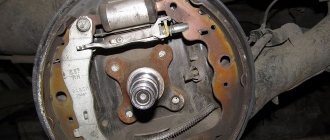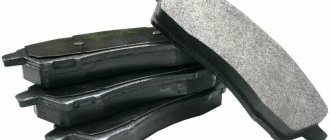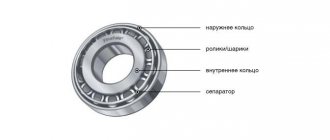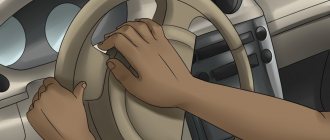The Lada Granta brake pads have a lifespan of 35 thousand kilometers, but in practice, replacing the front brake pads may be required much earlier, and it is worth doing the repair yourself without waiting for obvious signals about problems in the car’s braking system.
Otherwise, the car may pose a potential threat to you and other road users, since there is a high risk of complete loss of controllability at the most inopportune moment. Replacing the front brake pads on a Lada Granta is always carried out simultaneously on a pair of wheels. The operation is quite simple and most car owners prefer to do such repairs with their own hands, without going to a service station. For those who plan to change the pads themselves for the first time, we recommend that you start by familiarizing yourself with the diagram of this vehicle unit.
Required spare parts
To replace, you need to purchase new front brake pad assemblies with article number 2110-3501089, GDB458, 21100350180082, V210, 2108-3501090 or 2110-3501080. The device is offered in packs of 4 pieces. The price of the set varies from 400 to 1600 rubles. The new parts must exactly match the dimensions of the old pads. As an alternative to Russian spare parts, you can consider the Bosch brand or Chinese analogues, but you should be extremely wary of the latter.
Required Tools
To complete the work you will need:
- a pump to remove excess brake fluid; if there is none, you can use a syringe or an enema;
- slotted screwdriver;
- hard brush;
- open-end wrench 17;
- spanner 13;
- pliers;
- clamp;
- shoes for supporting wheels, can be replaced with bricks;
- rags;
- jack;
- brake fluid.
Do-it-yourself work is well justified by saving time and money; as of May 31, 2020, the cost of replacing front brake pads in a car service starts from 600 rubles. Additionally, the car owner will be able to inspect his car, that is, carry out an inspection of it himself.
Order of Operations
Before the procedure for replacing brake pads on a Lada Granta car, you need to perform a number of preparatory measures:
- check the brake fluid level and pump out excess;
- fix the wheels;
- loosen the bolts on the wheel rims;
- jack up the car;
- Turn the car's steering wheel in the direction where the pad is being replaced.
After these steps, you can proceed directly to the repair:
- You need to find a plate with a bend that locks the cylinder fixing bolt. Use pliers to push the edges apart until the fasteners are accessible.
The guide pin is fixed.
The cylinder fixing bolt must be completely unscrewed and removed along with the plate.
Now you need to open the bracket, this opens the pads.
- Old devices are removed, and all dirt must be thoroughly cleaned from the seats using brushes and rags.
- After cleaning the seat, you can begin installing new parts. First you need to push the piston completely into the cylinder, otherwise it is impossible to install the bracket. The operation is performed using a powerful screwdriver or pliers.
- Further operations will be performed in reverse order.
- The procedure is carried out similarly with the second front wheel. Before you begin, you need to reinstall the jack and turn the steering wheel towards the wheel on which the work is being done.
- After replacement, you need to check the brake fluid level in the barrel and top up if necessary.
Read more: What winter tires to put on Lanos
Also watch replacing the front brake pads on a Lada Granta in this video:
Important! After replacement, you need to bleed the brakes. To do this, a beam or other device is installed under the rear wheels to tightly fix the wheels. Then the car starts and the brake pedal is worked.
Brake system of the Lada Granta 2190 car.
Brake system
- this is a car system, thanks to which you can control deceleration or reduction in speed, up to a complete stop, and also avoid movement or rolling when the car is parked.
The brake system of a Lada Granta car includes such elements as brake pads, brake cylinders, brake hoses and pipelines, a vacuum brake booster, a brake force distributor, a master cylinder, etc.
The Granta's braking system largely replicates that of the Lada Kalina. The system is two-circuit. This means that the 2 circuits operate independently of each other. That is, if one circuit loses its tightness, the second one remains operational. That is why the left and right sides of the car are included in one circuit. For safer braking, if one of the brake circuits fails, the right and left sides should brake equally. This is achieved by connecting pairs of wheels into one circuit: left front - right rear; right front - left rear.
For more efficient and comfortable braking, the Lada Granta uses a vacuum brake booster (VUT). It increases the force applied to the brake pedal several times. It should be noted that the VUT is operational only when the engine is running. Therefore, you should not turn off the car’s ignition when coasting down a hill - you will have the feeling that the brakes have disappeared.
Hydraulic diagram of Lada Granta brakes (version without ABS)
- 1, 25 — brake mechanisms of the right front and left front wheels;
- 2, 24 — brake hose for supplying brake fluid to the right and left front wheels;
- 3, 4, 15, 18, 21, 5, 10, 13, 22, 27 - hydraulic brake system pipelines;
- 6 — plastic reservoir of the brake master cylinder;
- 7 — main cylinder for hydraulic brakes;
- 8 — vacuum booster;
- 9, 30 — pipeline holders;
- 11 — flexible hose of the brake mechanism of the right rear wheel;
- 12, 17 - brake mechanism of the right rear wheel;
- 14, 31 — brackets for fastening flexible hoses;
- 16- flexible hose for the brake mechanism of the left rear wheel;
- 19 — elastic lever of the pressure regulator drive;
- 20 — pressure regulator;
- 23 – brake pedal;
- 24 — flexible brake mechanism of the left front wheel;
- 26 — tee of the circuit right front - left rear brake;
- 28 - tee of the left front - right rear brake circuit;
- 29 - tee mounting bolts Depending on the configuration, an anti-lock brake system can be installed on the Lada Granta, which prevents the wheels from skidding, thereby increasing stability and maintaining vehicle controllability during emergency braking.
Hydraulic diagram of Lada Granta brakes with ABS system - 1, 14, 22 — brackets for fastening flexible hoses;
- 2 — brake mechanism of the right front wheel;
- 3 — flexible hose of the brake mechanism of the right front wheel;
- 4, 5, 15, 18, 26 - pipelines of the right front - left rear brake circuit;
- 6, 10, 13, 27, 28 - pipelines of the left front - right rear brake circuit;
- 7 — plastic reservoir of the main brake cylinder;
- 8-vacuum booster;
- 9, 24 — pipeline holders;
- 11 — flexible hose of the brake mechanism of the right rear wheel;
- 12 — rear wheel brake mechanism;
- 16 - brake mechanism of the rear left wheel;
- 17 — flexible hose of the brake mechanism of the left rear wheel;
- 19 – brake pedal; 20-brake mechanism of the left front wheel;
- 21 — flexible hose of the brake mechanism of the left front wheel;
- 23 — main cylinder for hydraulic brakes;
- 25 — hydro-electronic ABS module
In this section you can find a description of replacing brake pads, hoses, and the operation of the vacuum brake cylinder.
Let's summarize
As you can see, the process of replacing brake pads is not complicated; it is important to initially understand how to fix it. The work will not take much time - half an hour, and the second or third time you will do it even faster. Pay attention to the sounds when braking: if there is a whistle, grinding or creaking, you feel kickback in the pedal, the system begins to “beat” - it’s time to install new pads. Practice shows that on a Lada Granta, for a driver with a calm driving style, the service life of the kit increases to 50 thousand kilometers, for motorists and reckless drivers it decreases to 30 thousand kilometers.
In general, this is the case, I drove on factory TIIR pads, you all know them very well, and I think I’m sick of this creaking sound when I press the brake! A friend recommended pads from the Markon company (I think that’s what they’re called), they didn’t creak on his Chevrolet Niva!
After driving about 1 thousand km they whistled like a cop's UAZ! After about another 300 km they began to whistle like a suu... gopher! I later realized that the factory ones were just whispering and not whistling compared to Markon. I thought about putting the factory ones back but then I remembered that I threw them away! =)
Just a song and not pads, but imagine in traffic jams for half an hour to an hour and a half! My mind just explodes! Yes, it's a shame =)
I was searching on the Internet and found out what kind of pads do not creak on the Grant. A lot of people wrote about Feradoo (green, they are soft and brake worse) and Ferado (red, they brake better but wear out the brake disc faster), everyone says that the green ones squeaked after a certain mileage, then everyone apparently started buying red ones. But the result is that they still creaked sooner or later.
When I saw a Lada Granta passing in a traffic jam on the street, I wanted to run out of the car and ask, “What brand of pads do you have!” =))) I then heard this creak from everyone, like a block maniac =))))
Read more: Negative camber spacers for rear wheels of VAZs
But after searching on the Internet, I found a video recording of one dude who was talking about TRW GDB 1446 pads.
Then I found a blog post for Daseros (Lada Kalina) and asked him about the creaking, he answered me “I drove 15 thousand, there wasn’t a single creaking... these are pads for Europe. Excellent))) I’m shocked)”
The next day I started looking like crazy for TRW GDB 1446 pads, we didn’t have them in the car markets and in stores either! But after searching the Internet I found it on the website www.exist.ru/price.aspx?p >
Now they cost 1,228.33 rubles due to the dollar jump. And then they came, I immediately checked the license via my mobile phone using the QR code, everything was fine and not a fake =)
Working on the brakes on a Grant is required when the car begins to wobble when braking, and extraneous noises are heard in the area of the rear wheels. What’s worse is if one of the wheels starts to jam when stopping. This article describes a step-by-step replacement of Grant's rear brake pads.
How to choose and which ones are better to buy brake pads for Granta
The supply of brake system elements for Grant is carried out by. Specialization: trucks and cars. Since the end of 2012, JSC TIIR has been supplying front overlays made of composite material (1118-3501090). The peculiarity of the components is the absence of anti-creaking plates in the design. A special mastic is applied to the back side to suppress noise, vibrations, and squeaks.
The technology showed a number of shortcomings and in 2013 TIIR supplied new pads under the index (2192-3501090-10). They are also made of composite material under the number TIIR-299. Anti-squeak plates “Nulok” for Lada Granta are installed on the outside. The rear circuit is equipped with disc-type pads (21920-3502090-10). Components are also supplied by JSC TIIR. The number of the composite material TIIR is 444.
How to replace Grant rear brake pads without ABS
Let's look at the whole process step by step. To work you will need :
- New pads (choose depending on whether the car has ABS or not);
- Keys 13: open-end and ratchet with long head;
- Wheel key;
- Head E-8;
- Head for 7;
- Screwdrivers for removing and installing springs;
- Pliers.
Preparing to replace pads
Getting ready to remove the brake pads. For this:
We support the wheels, remove the handbrake and wheel.
How to remove a brake drum on a Lada Granta
The drum on the Grant is removed like on any other VAZ model. To do this, use a 7 key to unscrew the guide pins and remove the drum.
It is not recommended to knock the drum with a mallet or hammer - there is a risk of damaging it.
Replacing pads yourself
Attention : from this moment on, do not press the brake pedal. Otherwise, the brake pistons will extend and removal/installation will be difficult.
Step 1 : To loosen the springs, press the pads inward. We press them out with a pry bar, focusing on the brake shield.
Move the brake pads.
Step 2 (based on the picture below) – remove:
- upper spring No. 5;
- expansion bar No. 6;
- lower spring No. 13;
- guide springs No. 7 (available on both pads).
At this stage we need springs 5, 13, 7 and bar 6.
Step 3 : freely remove the left block. The handbrake lever is attached to the right one - so we pull out the block itself and use pliers to remove the cotter pin securing its finger to the block.
Read more: Mitsubishi ASX oil change
We remove the handbrake lever from the cable, remove the cotter pin and disconnect the handbrake lever from the block.
Step 4 : assembly with new pads is done in reverse order.
If the new shoes make it difficult to put on the drum, they can also be pressed inward using pry bars.
How to change rear pads on a Lada Granta
An anti-lock braking system can be installed on the Lada Granta. Replacing Grant rear pads with and without ABS is practically no different. The only difference is the presence of a sensor, which must be disconnected when changing the ABS pads.
Read more: Suspension CV joint bearing Ford Focus 2
Attention: rear pads should only be replaced as a set. It is unacceptable to change the pads on only one side;
Before replacing the rear pads of the Lada Granta, you should check the brake fluid level. If it is close to the maximum, you need to use a rubber bulb to take some liquid into the prepared container.
The pads are changed in stages: first on one side, then on the other.
Replacing the Grant rear pads is done as follows:
- fully lower the handbrake lever;
- loosen the tension on the handbrake adjusting bolt;
- unscrew the guide pins holding the brake drum;
- clean the brake drum seat located on the wheel hub from dirt;
- treat the seat with WD-40;
- tap the drum with a rubber-faced hammer to facilitate subsequent dismantling;
- screw the bolts into the threaded holes on the drum and compress the drum, tightening the bolts evenly;
Attention: if you press the brake pedal with the brake drum removed, the pistons may fall out of the brake wheel cylinder, so this is not permitted!
- carry out a visual inspection of the brake drum (there should be no cracks, chips, deep marks);
- using a pair of mounting blades, bring together the rear pads of the Grant;
- Using pliers or a slotted screwdriver, remove the end of the upper spring that tightens the pads;
- disconnect the upper spring;
- lower the front pad and remove it together with the lower spring that tightens the pads;
- remove the upper tension spring;
- remove the spacer bar;
- remove the hook of the brake spacer lever from engagement with the parking brake cable;
- remove the second (rear) block;
- Unscrew the axial pin of the spacer lever using pliers;
- remove the washer from the block;
- disconnect the spacer lever and axial pin;
- clean the mechanism parts from corrosion and dirt;
- make sure there is no leakage of brake fluid from the working cylinder (if the cylinder is leaking, it must be replaced);
- attach the axial pin, spacer lever and spring to the new block;
- install the block;
- Use pliers to install the cotter pin on the axial pin;
- hook the end of the handbrake cable to the spacer lever;
- install a spacer bar;
- put the second block in place, having first put the lower spring on the blocks;
- Use pliers or a slotted screwdriver to tighten and install the upper tension spring;
- install the brake drum;
- tighten the two guide pins;
- press the brake pedal several times until the pads are in the working position;
- install the wheels, tighten the fastening bolts;
- remove the car from the jack;
- replace the pads on the second wheel.
Now you know how to replace the rear pads of the Lada Granta and you can do it yourself.
Replacing back pads on a Grant with ABS
Lada Granta with ABS has minor design features:
- equipped with ABS sensors (also known as wheel rotation sensors);
- rear pads have holes for sensors;
- The ABS sensor master disk is located under the drum.
The differences between brakes with ABS and conventional ones are insignificant and do not make it difficult to replace the pads.
The first step when replacing brakes on a Granta with ABS will be to remove the sensors (see figure below):
The ABS sensor is removed from the back of the wheel. You can try to remove the pads without removing the sensor.
Second step : remove the drum (as described above) and the drive disk underneath it. Otherwise, the procedure is the same as described above in the text.
At the end of the work, you can bleed the brake pedal and add brake fluid if necessary. If after pumping the liquid leaves, there is a leak somewhere.
Check the operation of the handbrake : normal position - the parking brake is engaged at 3-4 clicks of the lever.
What else you should know about replacing pads
When choosing new pads in a store, you should pay attention to their quality and originality of the manufacturer. It is better to pay attention to trusted companies: ATE, Dafmi, brembo, STS, VATI. Cheap, low-quality products can brake much worse, and in a critical situation they can collapse, which will lead to loss of control over the car.
How can you tell if a particular wheel is slowing down?
Evidence that the brakes on a given wheel are working is a shine on the disc or drum:
Where are brake pads changed?
At an official dealer, or at any service station where they repair chassis. There are also specialists who specialize only in brake system repairs.
Is there an alternative to replacing the pads? How to increase the period of their replacement?
Yes, this is a brake pad restoration. When they simply change the friction layer. The cost is usually equal to or even more expensive than buying new pads, but the friction layer in this case is much thicker and of better quality, according to experts. As a result, the service life of the restored part increases several times.
How long does it take to change brake pads?
According to service station standards, 0.8 - 1.2 hours are allotted for replacing both rear and front pads, depending on the car model.
How often should you change brake discs?
Brake discs and drums do not require regular replacement very often. Usually they are enough for 3-4 sets of pads, after which severe wear of the disc will affect the braking efficiency and service life of the new pads. Sometimes, instead of replacing, it is enough to sharpen the brake disc itself, if its thickness allows it. We do the same with brake drums.
General issues
Let's figure out when you need to change the pads and what to choose from components.
When to change rear pads
The rear pads on the Grant are changed at the following indicators :
- the wheels make noise - rattle - vibrate when braking;
- 1.5 mm (or less) left on the pads;
- the pads have delaminated, causing the wheels to periodically jam;
- stopped holding the handbrake;
- You recently changed the front pads, but haven’t touched the rear ones yet.
Selection of components for Grants
We have compiled a table of article numbers for spare parts for replacing brakes. Here it is (can be used to search and order online):
List of article numbers for all spare parts that may be required for work.
For example:
Here are the results of searching for pads in one well-known online store.
Here is the same in another well-known online store.
There are never too many options.
ABS allows you to shorten braking distances and maintain maneuverability when braking.
Frequency of replacing the front pads of the Lada “Granta”
Even under normal operating conditions, the pads last a different number of kilometers. It could be 10 or 60 thousand kilometers. This partly depends on driving style, but the condition of the following parts plays an important role:
- brake hoses;
- retaining and damping brackets and springs;
- brake cuffs;
- brake discs;
- anthers;
- seals;
- adjusting rods;
- brake pad fastening.
Faults in these elements gradually accumulate, which leads to loss of brake efficiency and accelerated or uneven wear of the pads. The service life of the pads is affected by the reagent that is used on roads in winter. Therefore, no one can name the exact mileage of the car at which the brake pads need to be changed. Therefore, it is necessary to control the thickness and condition of the linings on the pads. If they are thinner than 1.5 mm, peeled off, charred or crumbled, it is necessary to replace the Lada Granta pads.
Reminder
Let's summarize the key points :
- Granta with ABS has special pads, an ABS control disc and sensors that must be disconnected before disassembling the brake drum;
- When the drum does not come off well, you can remove it in another way: screw the pins 7 into the holes next to which they were screwed in (for more details, see the section How to remove a brake drum);
- Do not press the brake pedal after removing the drum;
- If you do not pump out excess brake fluid before starting work, it may be squeezed out after replacing the pads.
Have something to add to the article? Write everything in the comments!
